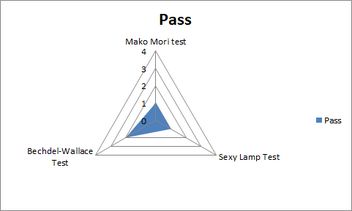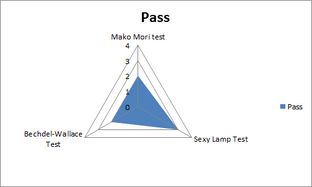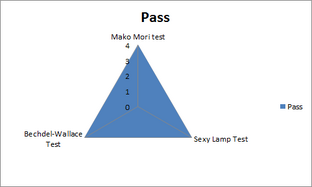The Crystal Gems test[1][2] is an omnibus media test which combines three other media tests - Bechdel-Wallace, Mako Mori and Sexy Lamp - and rates the work by number of characters passing each test. The test was devised and released by Locuas on Tumblr in August 2015, and is named after the "Crystal Gems", three of the major characters on the animated series Steven Universe.
Summary[]
According to the test, to pass this omnibus test, a work must fall within the following parameters:
- A work has to Have at least four female Characters;
- It must pass the Bechdel Test;
- It must pass the Mako Mori Test;
- It must pass the Sexy Lamp Test;
- Each [major female] character must pass at least one of these tests, and each test must be passed by at least one [major female] character;
- the more times you can repeat the previous step, the better.

"C-grade" passing Crystal Gems test.
Locuas states that the barest minimum for clearing the Crystal Gems test is at least two characters who pass Bechdel-Wallace, one of whom passes both Mako Mori and Sexy Lamp (similar to a "C grade").

"B-grade" for passing Crystal Gems test.
A "decent" passage by the Crystal Gems test would be a work featuring at least 3 characters who are Sexy Lamp-compliant, 2 of whom would pass both Bechdel-Wallace and Mako Mori (similar to a "B grade").

"A-grade" for passing Crystal Gems tes.
A full passage would have at least 4 characters passing all three tests (similar to an "A grade").
Having the characters completely fail at least one of the three tests results in failure of the entire Crystal Gems omnibus test.
Impact[]
The Crystal Gems omnibus test provides a wider range of rating inclusion of women in a work of fiction. Instead of "replacing" any other media test, this omnibus test uses three tests together and applies them from 2 to 4 characters. It also makes it easier to identify flaws in representation, plot-importance, relationships and development of characters.
References[]
- ↑ The Media Tests and a proposal (or “Women in Fiction” and Crystal Gems Test ), Locuas, Tumblr, Aug 26th, 2015
- ↑ Media Tests and “The Crystal Gems” Test, Locuas, October 5, 2015